Beijingopera
- 格式:doc
- 大小:68.50 KB
- 文档页数:1
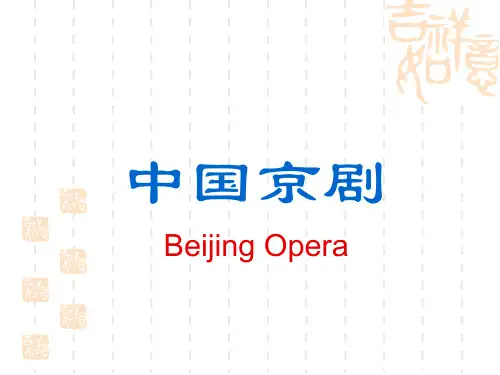
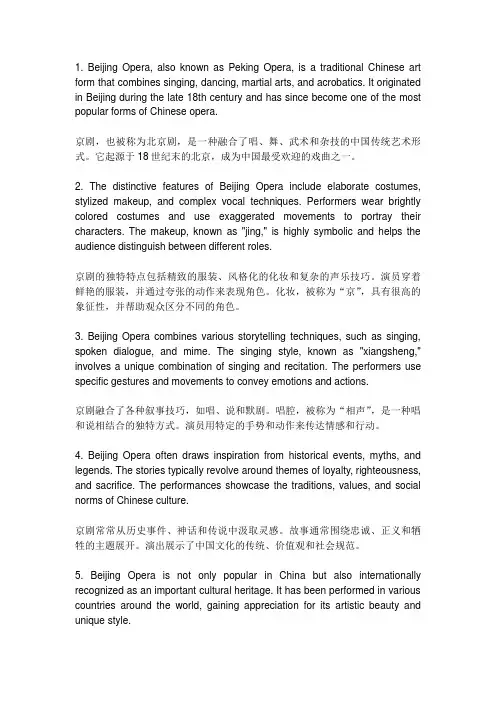
1. Beijing Opera, also known as Peking Opera, is a traditional Chinese art form that combines singing, dancing, martial arts, and acrobatics. It originated in Beijing during the late 18th century and has since become one of the most popular forms of Chinese opera.京剧,也被称为北京剧,是一种融合了唱、舞、武术和杂技的中国传统艺术形式。
它起源于18世纪末的北京,成为中国最受欢迎的戏曲之一。
2. The distinctive features of Beijing Opera include elaborate costumes, stylized makeup, and complex vocal techniques. Performers wear brightly colored costumes and use exaggerated movements to portray their characters. The makeup, known as "jing," is highly symbolic and helps the audience distinguish between different roles.京剧的独特特点包括精致的服装、风格化的化妆和复杂的声乐技巧。
演员穿着鲜艳的服装,并通过夸张的动作来表现角色。
化妆,被称为“京”,具有很高的象征性,并帮助观众区分不同的角色。
3. Beijing Opera combines various storytelling techniques, such as singing, spoken dialogue, and mime. The singing style, known as "xiangsheng," involves a unique combination of singing and recitation. The performers use specific gestures and movements to convey emotions and actions.京剧融合了各种叙事技巧,如唱、说和默剧。
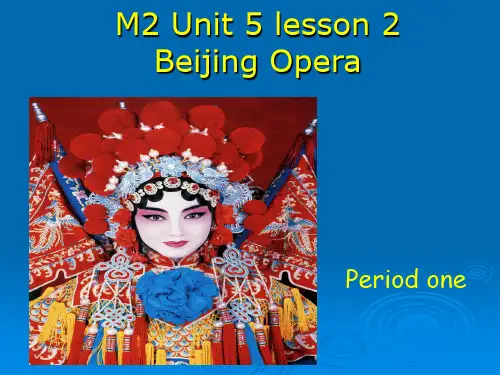
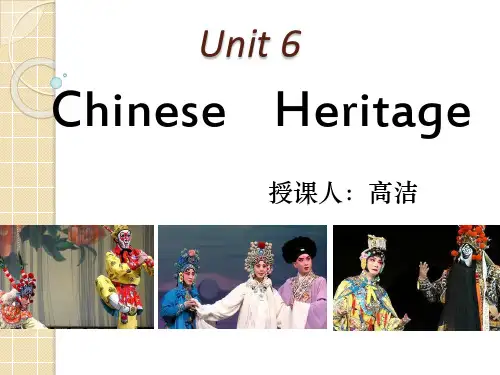
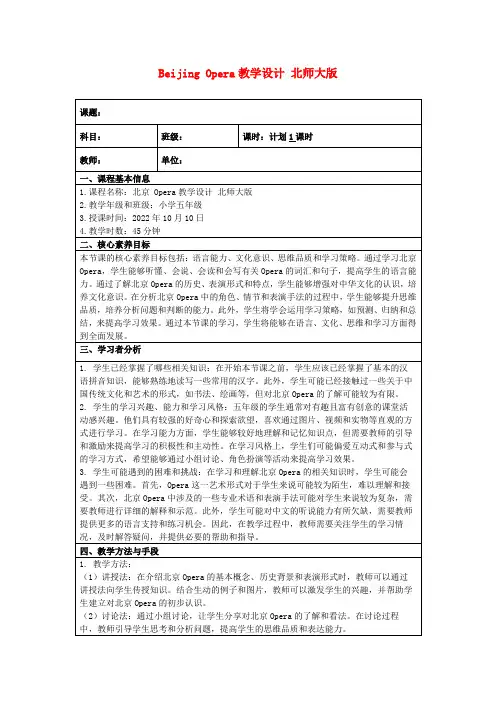
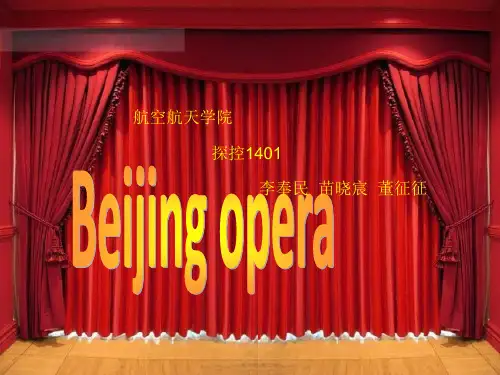
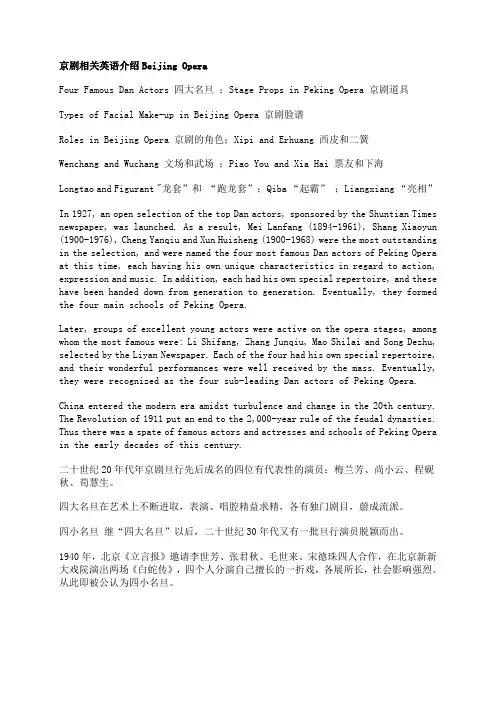
京剧相关英语介绍Beijing OperaFour Famous Dan Actors 四大名旦;Stage Props in Peking Opera 京剧道具Types of Facial Make-up in Beijing Opera 京剧脸谱Roles in Beijing Opera 京剧的角色;Xipi and Erhuang 西皮和二簧Wenchang and Wuchang 文场和武场;Piao You and Xia Hai 票友和下海Longtao and Figurant "龙套”和“跑龙套”;Qiba “起霸” ;Liangxiang “亮相”In 1927, an open selection of the top Dan actors, sponsored by the Shuntian Times newspaper, was launched. As a result, Mei Lanfang (1894-1961), Shang Xiaoyun (1900-1976), Cheng Yanqiu and Xun Huisheng (1900-1968) were the most outstanding in the selection, and were named the four most famous Dan actors of Peking Opera at this time, each having his own unique characteristics in regard to action, expression and music. In addition, each had his own special repertoire, and these have been handed down from generation to generation. Eventually, they formed the four main schools of Peking Opera.Later, groups of excellent young actors were active on the opera stages, among whom the most famous were: Li Shifang, Zhang Junqiu, Mao Shilai and Song Dezhu, selected by the Liyan Newspaper. Each of the four had his own special repertoire, and their wonderful performances were well received by the mass. Eventually, they were recognized as the four sub-leading Dan actors of Peking Opera.China entered the modern era amidst turbulence and change in the 20th century. The Revolution of 1911 put an end to the 2,000-year rule of the feudal dynasties. Thus there was a spate of famous actors and actresses and schools of Peking Opera in the early decades of this century.二十世纪20年代年京剧旦行先后成名的四位有代表性的演员:梅兰芳、尚小云、程砚秋、荀慧生。
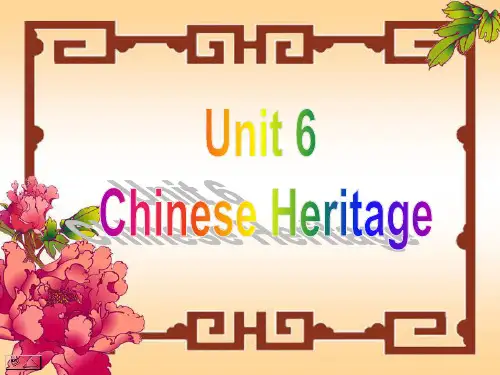

beijing opera英语作文高中Beijing Opera: A Captivating Fusion of Art, History, and TraditionBeijing Opera, also known as Peking Opera, is a unique and captivating form of traditional Chinese theater that has captivated audiences for centuries. This elaborate and multifaceted art form combines elements of music, dance, acrobatics, and stunning visual displays to create a truly mesmerizing experience. As one of the most well-known and iconic cultural traditions of China, Beijing Opera holds a special place in the hearts of both locals and international audiences alike.At the core of Beijing Opera lies a rich and complex history that dates back to the 18th century. The origins of this art form can be traced to the merging of various regional opera styles, each with its own distinct characteristics and traditions. Over time, Beijing Opera evolved into a highly refined and sophisticated genre, incorporating elements from Kun opera, Hui opera, and other regional performance traditions. This fusion of diverse influences has resulted in a truly unique and captivating art form that continues to captivate audiences around the world.One of the most striking features of Beijing Opera is its intricate and visually stunning costumes and makeup. Performers are adorned in elaborate, brightly colored garments that often feature intricate embroidery and intricate patterns. The use of elaborate headdresses, masks, and face paint is also a hallmark of Beijing Opera, with each character having a distinct and recognizable appearance. This attention to detail is not merely aesthetic but also serves to convey the personality and role of each character within the performance.The music of Beijing Opera is equally captivating, with a unique and complex musical structure that blends traditional Chinese instruments with Western-influenced elements. The orchestra, known as the Jingju, is composed of a variety of traditional Chinese instruments, including the erhu (a two-stringed fiddle), the pipa (a four-stringed lute), and the dizi (a bamboo flute). These instruments, along with percussion and vocal elements, create a rich and powerful soundscape that is both mesmerizing and emotionally evocative.The vocal styles of Beijing Opera are equally distinctive, with performers utilizing a range of techniques that include high-pitched trills, vibrato, and intricate melodic ornamentation. The singing is often accompanied by a unique style of recitation, known as "Xipi" and "Erhuang," which adds an additional layer of complexity and depth to the performance.In addition to the music and visual elements, Beijing Opera is also renowned for its acrobatic and choreographic elements. Performers often engage in intricate and physically demanding movements, including leaps, tumbles, and high-flying stunts. These acrobatic feats are seamlessly integrated into the storytelling, adding an additional layer of excitement and drama to the performance.The stories and narratives of Beijing Opera are equally captivating, drawing from a rich tapestry of Chinese history, mythology, and folklore. These stories often explore themes of love, loyalty, and heroism, with complex and multi-layered characters that capture the imagination of the audience. From the tragic love story of the Butterfly Lovers to the epic tale of the Monkey King, Beijing Opera's repertoire is a testament to the depth and richness of Chinese cultural heritage.Despite the enduring popularity of Beijing Opera, the art form has faced numerous challenges in recent decades. The rise of modern entertainment and the changing cultural landscape have led to a decline in the popularity of traditional theater, with younger generations often finding it difficult to connect with the complex and highly specialized nature of Beijing Opera. However, there are ongoing efforts to preserve and revitalize this art form, with organizations and institutions working to promote its appreciation and understanding both within China and on the global stage.In conclusion, Beijing Opera is a truly remarkable and captivating art form that embodies the rich cultural heritage of China. From its intricate costumes and stunning visual displays to its complex musical structure and captivating storytelling, Beijing Opera is a testament to the enduring power of tradition and the human spirit. Whether you are a seasoned aficionado or a newcomer to this art form, the experience of witnessing a Beijing Opera performance is one that will leave a lasting impression on your heart and mind.。
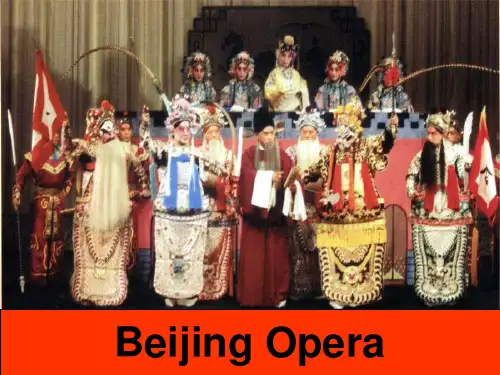

京剧(Beijing Opera/ Peking Opera)是中国的国粹。
作为一门古老的艺术,京剧的服装(costume)、脸谱(facial mask)更易被人喜爱。
不同的服装类型反映不同的人物身份特征。
富贵者的服装缀满精美的刺绣;穷困者的服装则简单朴素,少有装饰(elemental)。
脸谱是京剧中塑造人物形象的重要手段,它是用不同的颜色在脸上勾画出来的。
脸谱的颜色让人一看便知角色(portray)的善恶。
比如白色代表奸诈(treachery),黑色代表正直不阿,黄色是骁勇,蓝、绿色多用于绿林好汉(rebellious fighters),金、银色多用于神佛(divinity and Buddhism)等。
参考译文Beijing Opera is the cream of the Chinese culture. As a traditional art form, its costumes and facial mask are more popular with people. Different styles of costumes are used to reflect the status of different characters. There are more decorations in the costumes of nobles,while those of the poor tend to be simple and less elemental. Facial masks can reflect qualities of different characters. Facial masks using different colors are important ways to portray a character. People can tell a hero from a villain by the colors of the masks. In general,white usually represents treachery, black represents righteousness, yellow represents bravery, blue and green represent rebellious fighters,while gold and silver represent divinity and Buddhism.1。
Beijing Opera: A Timeless Treasure ofChinese CultureBeijing Opera, a unique and profound art form, has captivated audiences worldwide for centuries. Originatingin the imperial capital of Beijing, it has evolved overtime to become a symbol of Chinese cultural heritage and artistic excellence. The intricate costumes, vibrant colors, and intricate melodies combine to create a truly immersive experience that transports the viewer into a world of elegance and drama.At the heart of Beijing Opera is its meticulousattention to detail. From the elaborate costumes, eachstitch and embroidery a testament to the artisan's skill,to the carefully choreographed movements of the performers, every aspect of the performance is meticulously planned and executed. The actors, through their facial expressions and body language, convey deep emotional resonance, oftenwithout the need for spoken dialogue. This allows the audience to connect with the characters and their storieson a deeper level.Moreover, Beijing Opera is not just about entertainment; it is also a vehicle for social commentary and moral instruction. Through its stories and characters, itexplores themes such as loyalty, bravery, love, and sacrifice. These themes are presented in a way that is both accessible and thought-provoking, making Beijing Opera an important educational tool as well.The art of Beijing Opera is also noteworthy for its blend of different artistic disciplines. It incorporates elements of music, dance, drama, and visual art, creating a harmonious union that is both visually appealing andaurally captivating. The melodies, often played ontraditional Chinese instruments like the erhu and the pipa, are both haunting and uplifting, adding another layer of emotional depth to the performance.In today's fast-paced world, Beijing Opera remains a timeless reminder of the rich cultural heritage of China.It continues to draw new audiences, both domestic and international, who are fascinated by its unique blend of traditional and contemporary elements. The popularity of Beijing Opera has also led to the emergence of numerousfestivals and events dedicated to its promotion and preservation.As we look to the future, it is important to recognize the role that Beijing Opera plays in preserving and promoting Chinese cultural identity. By supporting and promoting this art form, we not only honor our ancestors but also ensure that future generations will have the opportunity to experience and appreciate the beauty and depth of Beijing Opera.In conclusion, Beijing Opera is not just an art form; it is a living testament to the richness and diversity of Chinese culture. Its ability to captivate and inspire audiences across the globe is a testament to its universal appeal and enduring value. As we continue to explore and appreciate the beauty of Beijing Opera, we also uphold the values and traditions that have shaped China's cultural landscape for centuries.**京剧:中华文化的不朽瑰宝**京剧,这门独特而深刻的艺术形式,几个世纪以来一直吸引着世界各地的观众。
京剧的英语作文高一英文回答:Beijing Opera.Beijing Opera, also known as Peking Opera, is a traditional Chinese art form that combines music, singing, dance, and acrobatics. It is one of the most popular and recognizable forms of Chinese opera, and is considered a national treasure.Beijing Opera has a long history, dating back to the 18th century. It originated in the imperial court of the Qing dynasty, and was originally performed for the emperor and his entourage. Over time, it became more popular with the general public, and is now performed in theaters and opera houses all over China.Beijing Opera is characterized by its elaborate costumes, makeup, and stage sets. The costumes aretypically made of silk and satin, and are brightly colored and decorated with intricate embroidery. The makeup is also very elaborate, and is used to create a variety of characters, from heroes and villains to gods and demons. The stage sets are often very elaborate, and can include palaces, temples, and gardens.The music of Beijing Opera is also very distinctive. It is based on a system of five-tone scales, and is played on a variety of instruments, including the pipa, erhu, and zheng. The singing is also very stylized, and is often accompanied by gestures and dance.Beijing Opera is a highly skilled art form, and requires years of training to master. The performers must be able to sing, dance, act, and fight, and must also be proficient in a variety of musical instruments.中文回答:京剧。
京剧(Beijing Opera)又称平剧、京戏,是中国影响最大的戏曲剧种,分布地以北京为中心,遍及全国。
清代乾隆五十五年起,原在南方演出的三庆、四喜、春台、和春四大徽班陆续进入北京,他们与来自湖北的汉调艺人合作,同时接受了昆曲、秦腔的部分剧目、曲调和表演方法,又吸收了一些地方民间曲调,通过不断的交流、融合,最终形成京剧。
京剧流播全国,影响甚广,有“国剧”之称。
它走遍世界各地,成为介绍、传播中国传统文化的重要手段。
京剧是在北京形成的戏曲剧种之最,至今已有200年的历史。
它是在徽戏和汉戏的基础上,吸收了昆曲、秦腔等一些戏曲剧的优点和特长逐渐演变而形成的。
公元1790年(清乾隆55年),徽戏开始进京。
最早进京的徽戏班是享有盛名的安徽“三庆班”,随后又有“四喜”、“和春”、“春台”诸班,史称“四大徽班”(四大徽班从扬州进京)。
四大徽班和以后陆续进京的徽班,以其优美动听的唱腔和卓越的表演受到观众的欢迎。
[1]现在它仍是具有世界级影响的大剧种。
它的行当全面、表演成熟、气势宏美,是近代中国汉族戏曲的代表。
[2]京剧起源于四个地方的剧种:一是原来流行于安徽省一带的徽剧;二是流行于湖北的汉剧;三是流行于江苏一带的昆曲;四是流行于陕西的秦腔,又叫梆子。
清乾隆末期、嘉庆初期四大徽班进北京后,于嘉庆、道光年间同来自湖北的汉调艺人合作,互相影响,逐渐接受了昆曲、秦腔的部分剧目、曲调和表演方法,并吸收了一些民间曲调、北京土语,逐渐融合发展。
[3]唱指歌唱,念指具有音乐性的念白,二者相辅相成,构成歌舞化的京剧表演艺术两大要素之一的“歌”,做指舞蹈化的形体动作,打指武打和翻跌的技艺,二者相互结合,构成歌舞化的京剧表演艺术两大要素之一的“舞”。
唱、念、做、打京剧表演的四种艺术手法,也是京剧表演四项基本功。
戏曲演员从小就要从这四个方面进行训练,虽然有的演员擅长唱功(唱功老生),有的行当以做功(花旦)为主,有的以武打为主(武净)。
Beijing Opera (Pekese opera)——京剧。
Pekinese为北京的,现为Beijing,opera是歌剧的意思。
基本解释:[Beijing opera] 我国主要剧种之一,由清代中叶的徽调、汉调相继传入北京合流演变合成。
腔调以西皮、二黄为主,用胡琴和锣鼓等伴奏,后流行于全国基本概念:京剧是在北京形成的戏曲剧种之一,至今已有将近二百年的历史。
它是在徽调和汉戏的基础上,吸收了昆曲、秦腔等一些戏曲剧种的优点和特长逐渐演变而形成的。
京剧音乐属于板腔体,主要唱腔有二黄、西皮两个系统,所以京剧也称“皮黄”。
京剧常用唱腔还有南梆子、四平调、高拔子和吹腔京剧角色的行当划分比较严格,早期分为生、旦、净、末、丑、武行、流行(龙套)七行,以后归为生、旦、净、丑四大行,京剧脸谱的分类有:整脸、英雄脸、六分脸、歪脸、神仙脸、丑角脸等。
中国传统戏曲的脸谱,是演员面部化妆的一种程式。
一般应用于净、丑两个行当,其中各种人物大都有自己特定的谱式和色彩,借以突出人物的性格特征,具有“寓褒贬、别善恶”的艺术功能,使观众能目视外表,窥其心胸。
因而,脸谱被誉为角色“心灵的画面”。
蔡阳:《古城会》京剧脸谱,是根据某种性格、性情或某种特殊类型的人物为采用某些色彩的。
红色有脸谱表示忠勇士义烈,如关羽、姜维、常遇春等,用作辅色暗示人物命运,如蒋忠、华雄、高登等;黑色的脸谱表示刚烈、正直、勇猛、粗率,甚至鲁莽,如包拯、张飞、李逵、项羽、杨七郎等;黄色的脸谱表示彪悍、阴险、凶狠残暴,如庞涓、宇文成都、典韦。
蓝色或绿色的脸谱表示一些刚强骁勇、粗犷、桀骜不驯的人物,如窦尔敦、马武、程咬金、公孙胜等;白色的脸谱一般象征阴险狡诈的坏人,如曹操、严嵩、赵高、秦桧、司马懿等。
朱温:《雅观楼》画出下垂的鬓角,其子铫刚的眼角却呈上翘之势,加上夸大的光嘴巴,一看便是血气方刚;再如关羽“面如重枣”,自然画红脸,包拯“铁面无私”则黑脸非他莫属,曹操“面带奸诈”便是一幅奸白脸。
Hello, everybody,
Do you know what quintessence of Chinese culture is? Which one is typical Chinese art in the eye of foreigner? Which opera was most popular in the last two hundred years in China? I think you already got the answer: it’s Beijing Opera.
Beijing opera, Chinese called Jingju is a form of traditional Chinese theatre which combines music, vocal performance, mime, dance and acrobatics. It arose in the late 18th century when the “Four Great Anhui Troupes” brought Anhui opera (Huiju), to Beijing i n 1790, for the birthday of the Qianlong Emperor. It became fully developed and recognized by the mid-19th century. The form was extremely popular in the Qing Dynasty court and has come to be regarded as one of the cultural treasures of China. Major performance troupes are based in Beijing and Tianjin in the north, and Shanghai in the south. Now the art form is also enjoyed in Taiwan and even spread to other countries such as the United States and Japan.
Beijing opera features four main types of performers: Sheng, Dan, Jing, Chou. The main role of them are Sheng and Dan. The Sheng is the main male role in Beijing opera. The role has numerous subtypes. The laosheng is a dignified older role. These characters have a gentle and cultivated disposition and wear sensible costumes. Young male characters are known as Xiaosheng. These characters sing in a high, shrill voice with occasional breaks to represent the voice changing period of adolescence. The Wusheng is a martial character for roles involving combat. They are trained in acrobatics, and have a natural voice when singing. The Dan refers to any female role in Peking opera. Dan roles were originally divided into five subtypes. Old women were played by Laodan, martial women were Wudan, young female warriors were Daomadao, virtuous and elite women were Qingyi, and vivacious and unmarried women were hudan. The most famous performers as Dan were Mei Lanfang, Cheng Yanqiu, Shang Xiaoyun and Xun Huisheng, they were all known to everybody before liberation.
In modern society, Beijing Opera is no longer as popular as the past. In recent years, Beijing opera has attempted numerous reforms in response to sagging audience numbers. These reforms, which include improving performance quality, adapting new performance elements, and performing new and original plays, have met with mixed success. Some Western works have been adopted as new plays. I hope Beijing Opera will replay its splendid history in the near future.
DOW RESTRICTED - For internal use only。